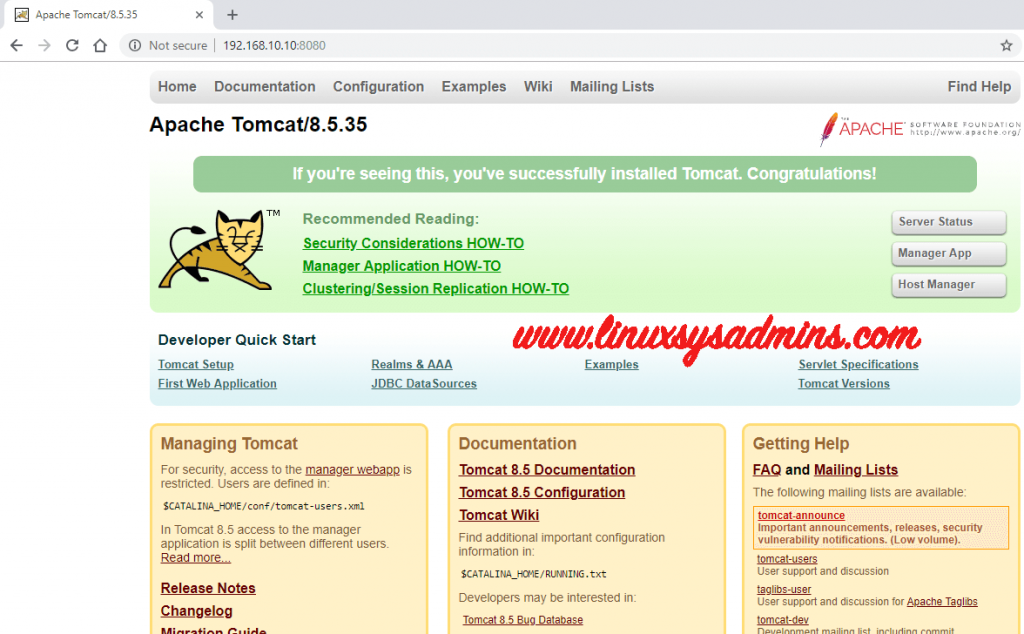

- #DOWNLOAD TOMCAT 8.5 FOR CENTOS 7 INSTALL#
- #DOWNLOAD TOMCAT 8.5 FOR CENTOS 7 ARCHIVE#
- #DOWNLOAD TOMCAT 8.5 FOR CENTOS 7 SOFTWARE#
- #DOWNLOAD TOMCAT 8.5 FOR CENTOS 7 DOWNLOAD#
Upgrading to this version may significantly impact the operation of your database and applications. Please read this document carefully to understand all the changes in the Tomcat 8 release. See the Official Tomcat 8.5 Release Notes for a list of changes that may cause issues when upgrading. IMPORTANT: Tomcat 8.5 has an extensive list of new features and changes. If you need more information about setting up a Virtual Server for staging or testing, please contact eApps Sales. If necessary, you can rebuild your staging Virtual Server on demand so that you have a fresh installation to test on.
#DOWNLOAD TOMCAT 8.5 FOR CENTOS 7 SOFTWARE#
This approach will allow you to minimize the risk of data loss and downtime of your production service when performing software upgrades. If you are upgrading from any prior version of Tomcat to Tomcat 8, there is a HIGH RISK of data loss and downtime if you do not carefully test your existing database and application with this new version.ĮApps recommends, as a best practice, to maintain a staging server where you can test software upgrades before moving them into production. This release has introduced new functionality and significant changes to the existing Tomcat server. Tomcat 8.5 is a major release of the Tomcat application server. There is no support for Java SE 6 in Tomcat 8.5 Tomcat 8.5 is designed to run on Java SE 7 and above.

Contact eApps Sales for more information. If you are on a CentOS 5 (Webmin) or CentOS 4 (VPS) plan and need Tomcat 8.5, you will need to migrate to a CentOS 6 (ISPmanager) plan. Tomcat 8.5 is only available for Virtual Servers running CentOS 6 or CentOS 7. You may also need to create a Virtual host or configure a SSL certificate in Tomcat.This Release Note covers all point releases for the Tomcat 8 that are offered by eApps. You have a running Tomcat 8.5 server on your CentOS 8 system. To connect from remote machine use IP address of the system with port: Conclusion If you are connecting from the local machine then use the localhost. To access Tomcat on the web browser by connecting your server on port 8080. Tomcat server works on port 8080 default. Then, enable and start Tomcat service on your system sudo systemctl enable rvice Reload the systemd daemon service to apply changes sudo systemctl daemon-reload Create a rvice file with the following content: sudo vim /etc/systemd/system/rviceĮnvironment="JAVA_OPTS=file:///dev/urandom"Įnvironment="CATALINA_PID=/opt/tomcat/temp/tomcat.pid"Įnvironment="CATALINA_OPTS=-Xms512M -Xmx1024M -server -XX:+UseParallelGC" But you can also create a startup script to manage Tomcat via systemctl command. Tomcat provides bash scripts for start or stop service. Edit conf/tomcat-users.xml file in your editor and paste inside tags.


The latest Tomcat versions do not allow manager and host-manager interface for remote users. Step 4 – Enable Host/Manager for Remote IP Sudo mv apache-tomcat-8.5.75/* /opt/tomcat/Īlso, set the proper ownership of all files.
#DOWNLOAD TOMCAT 8.5 FOR CENTOS 7 ARCHIVE#
Then extract the archive file and copy all the files under tomcat home directory tar xzf apache-tomcat-8.5.75.tar.gz
#DOWNLOAD TOMCAT 8.5 FOR CENTOS 7 DOWNLOAD#
You can use below wget command to download it. Step 3 – Download Tomcat 8ĭownload Apache Tomcat archive file from Apache tomcat official download page. The above command will create user “tomcat” with the group “tomcat”. sudo useradd -m -d /opt/tomcat -U -s /bin/false tomcat So, I always prefer to create a separate user account to run the Tomcat server on the Linux system. Which is not the correct way for security purposes. Many of the system administrators are run the Tomcat server with root user. OpenJDK 64-Bit Server VM 18.9 (build 11.0.4+11-LTS, mixed mode, sharing) OpenJDK Runtime Environment 18.9 (build 11.0.4+11-LTS) Then check the installed Java version java -version
#DOWNLOAD TOMCAT 8.5 FOR CENTOS 7 INSTALL#
If you don’t’ have Java installed, use the following command to install java (OpenJDK) on your system. Make sure you have Java 8 or higher version installed in your system. Java is the primary requirement for running Tomcat 8.5 on CentOS 8 Linux system. To know more about the Apache Tomcat visit apache official site. We use Tomcat for deploying Java Servlet and JSP applications. Tomcat is an open-source web server for the Java-based applications developed by the Apache Foundation. Apache Tomcat 8.5 is the latest version available for the installation of the Tomcat 8 series.


 0 kommentar(er)
0 kommentar(er)
